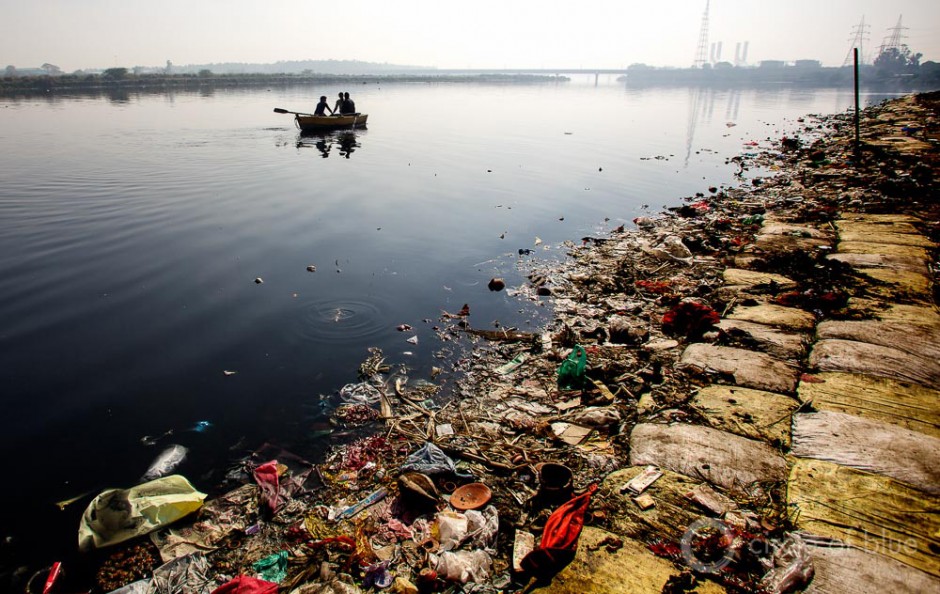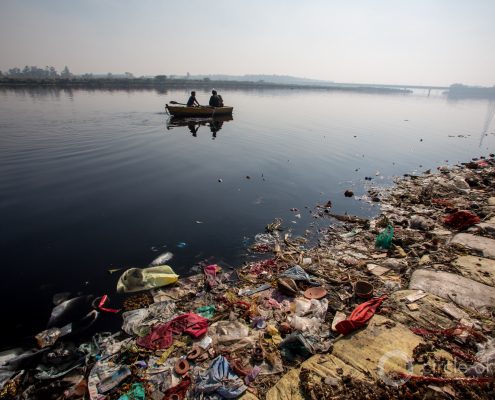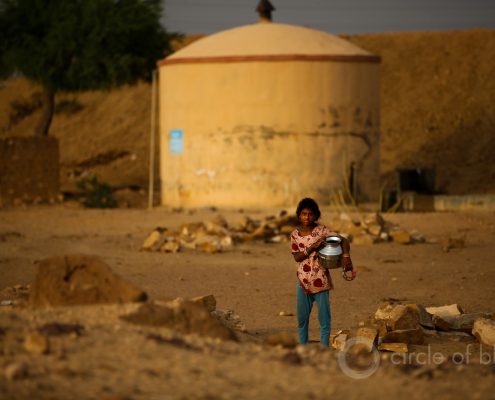Experts warn that Delhi could reach “zero groundwater levels” by 2020.

The Yamuna River, a tributary of the Ganges, is widely recognized as India’s most polluted river. Photo © J. Carl Ganter / Circle of Blue
By Kayla Ritter, Circle of Blue
Delhi is running short — maybe even out — of groundwater.
A harrowing report in June from NITI Aayog, a government-chartered think tank, warned that Delhi, along with 20 other Indian cities, could reach “zero groundwater levels” by 2020.
It was a stunning claim that drew attention to an urgent sustainability question in a country that pumps more groundwater than any other.
It’s also a hard claim to prove. Veena Srinivasan, leader of the Water, Land, and Society Program at Ashoka Trust for Research in Ecology and the Environment, told Circle of Blue that she doesn’t believe this claim can be substantiated. But groundwater decline is still a key challenge in underserved, fast-growing suburbs of the city, she said.
Whether its leaders can guide Delhi, poised to become the largest metropolitan area in the world within the next decade, through a period of rapid population growth while maintaining an adequate water supply is one of the most critical questions in the city today.
A Plethora of Problems
Like other global megacities, some the size of small countries, Delhi is attempting to accommodate the needs of tens of millions of people by layering new infrastructure atop water systems that were developed centuries ago.
Traditionally, the city relied on a water-supply network of check dams, stepwells, and natural drains. Under this system, rainwater was gathered during the monsoon season, then utilized throughout the year.
Recent decades of breakneck growth — the population of the metro area now approaches 29 million, according to the UN — led to the neglect of this ancient network. The city’s natural drains have largely been paved over or choked by waste. Lakes and other waterways have either dried up or become filled with trash and other pollutants. Sewage contamination is widespread.
“Sewers, where they exist, discharge untreated or partially treated water,” Upmanu Lall, a professor at Columbia University and director of the Columbia Water Center, told Circle of Blue.
Seasonal flooding also spreads contaminants throughout the city’s water supply, says Lall. “There are many areas that flood in the absence of sewers and mobilize anything that is on the ground.”
The status of surface water in Delhi is also grim. Residents rely on the Yamuna River, a tributary of the Ganges, for drinking, bathing, and washing. The river, however, is a toxic stew of sewage, industrial chemicals, and agricultural runoff. A recent report found that wastewater and fecal sludge from 1,500 unauthorized slums empties directly into the Yamuna.
Water distribution in the city is managed by the government-owned Delhi Jal Board. Eighty-one percent of Delhi households have some access to piped water, although the supply, which is drawn both from underground and from the Yamuna river, is not always clean or reliable. Water that goes into the pipes often does not stay there. Up to 40 percent of the city’s water is lost due to theft and leaks.
Based on the 2011 census, roughly 625,000 households are not attached to city pipelines at all. The majority of these households are located in slums or informal settlements.
Millions of residents who are excluded from, or underserved by, the city distribution system collect water from borewells or tanker trucks. Illegal borewells, some reaching more than 120 meters into the ground, are ubiquitous throughout the city. A March 2018 report found that groundwater is “overexploited” in 15 of Delhi’s 27 administrative divisions.
Illegal groundwater extraction has played a role in Delhi’s looming groundwater crisis, but other factors are at play. The Delhi metropolitan area comprises its own capital territory, and is bordered by Haryana and Uttar Pradesh, states that pump large amounts of groundwater for their own use, Lall said. Collectively, water users in the region are extracting groundwater faster than the natural recharge rate.
According to the Indian government’s 2016-2017 Ground Water Year Book, Delhi uses 390 million cubic meters of groundwater a year, about 25 percent higher than the natural recharge rate of 310 million cubic meters. That imbalance amounts to annual deficit spending that results in a drop in groundwater. Today, groundwater levels are considered critical or semi-critical in 90 percent of the city–and demand continues to grow.
The groundwater shortage is further complicated by Delhi’s unchecked urbanization, which is disrupting rejuvenation of the city’s aquifers. Concrete and other infrastructure has haphazardly overtaken the metropolis, blocking rainwater from absorbing into the ground.
Illegal extraction, regional consumption, and urbanization have taken a toll. According to a May 2018 government report, groundwater levels in Delhi now decrease, on average, by 0.5 to 2 meters per year. In some areas of Delhi, the water table is 80 meters below ground, down from around 40 meters in 2000.
In a trip to Delhi last year, Circle of Blue co-founder and director J. Carl Ganter witnessed the city’s water stress firsthand in the Sangram Vihar neighborhood. Like countless areas of Delhi, the informal settlement is not connected to the city’s water network, forcing residents to rely on alternative water sources.
“The cruel irony here in Delhi is that many living in the poorest informal neighborhoods like this one are water refugees,” noted Ganter in his reflections on the trip to Sangram Vihar. “They are families from nearby states like Rajasthan and Bundelkhand where fiercely persistent drought and over-pumping has caused wells to go dry, farms to go bankrupt, and some farmers even to take their own lives.”
Can Delhi’s Water Be Saved?
The NITI Aayog report declared that Delhi could exhaust its groundwater as soon as 2020. Some experts believe the city is doomed to this fate, as short-term growth outstrips an interest in long-term water sustainability. Other activists, though, are attempting to avoid this doomsday scenario, or to develop alternative water sources.
Restoration of the city’s traditional water networks is one way to spare Delhi’s water. Installing porous pavement in the city could help rainfall seep into the ground. The Delhi government is also placing renewed focus on wastewater treatment and rainwater harvesting.
In parts of the city, officials are taking a grassroots approach to water management. Recently, the community of Kirti Nagar became one of Delhi’s first slums to receive a sophisticated water supply network, with pipes that deliver clean water to the community twice a day. A group of local women act as “guardians” of the water network, and are responsible for notifying the government if the pipes or valves break.
In other slums, the government is working to improve water access, build latrines, and educate residents about the city’s water issues. So far, these efforts have proved somewhat successful, but only widespread change will reverse Delhi’s groundwater crisis.
Kayla Ritter is a recent graduate of Michigan State University, where she studied International Relations and Teaching English to Speakers of Other Languages. She is currently based in Manton, Michigan. Kayla enjoys running, writing, and traveling. Contact Kayla Ritter





